Lower Fort Garry artifacts
Lower Fort Garry National Historic Site
Highlights from the collection
Lower Fort Garry has 46,000 objects on-site. The artifacts featured here are selected from this larger collection of artifacts and historical reproductions. There are 13 buildings at Lower Fort Garry, including nine buildings furnished to represent the mid-1800s, three museum display spaces, and a gun powder magazine.
Parks Canada interpreters use these historic objects to present the story of Lower Fort Garry and provide visitors with a chance to encounter Manitoba's rich history. The objects on site are valuable cultural resources that are displayed for public enjoyment and also carefully protected for the benefit of future generations.
Cannons from York Factory
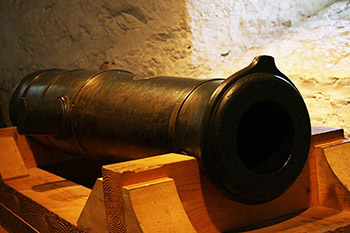
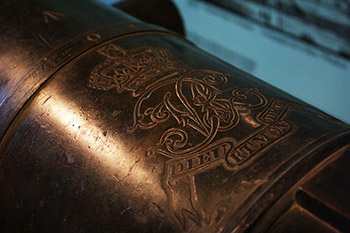
W. North Company
Cast bronze, with iron pieces of field carriage
Lower Fort Garry National Historic Site
HX.95.28.1; HX.95.28.2
These two cannons, made for the British army by the W. North Company in 1843, were intended for delivery to the Red River Settlement. Capable of firing 12-pound projectiles, these cannons, cast in bronze, weigh 693 pounds each. The cannons were initially meant to be transported by York boat with the 6th (Royal First Warwickshire) Regiment of Foot in 1846; however, the bulky equipment proved to be too heavy and difficult to manoeuvre. As a result, the cannons were left at York Factory, an important outpost of the Hudson’s Bay Company on the Hayes River. For years, the guns were situated in front of the Depot Building and used to mark the arrival of supply ships coming from Britain. In the mid-20th century, the cannons were moved to Churchill, and they remained in storage there until they were damaged by fire in the 1970s.
Conservators from the Department of Canadian Heritage carefully cleaned one fire-damaged cannon in 1981, using gentle soap, solvents, and steel wool. They then applied a coating of microcrystalline wax to protect the surface from future rusting. Following conservation, the cannons were moved to Lower Fort Garry, where they remain on display in the Southwest Bastion. After a delay of nearly 150 years, the cannons have finally found their originally intended resting place on the banks of the Red River.
Wooden plough
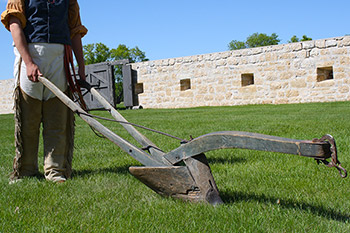
Maker: Duncan McRae
Iron and Wood
Lower Fort Garry National Historic Site
HG.61.1.342
This wooden plough with an iron ploughshare, bridle, and struts, was made by local stonemason Duncan McRae. Stonemasons were in high demand in the early days of the Red River Settlement: McRae was hired to work on the construction of Lower Fort Garry and other significant buildings in area, such as St. Andrew’s Church and Rectory. Alexander Lillie, the original owner of the plough, was the first farm manager at Lower Fort Garry. The plough was among the first to be made at the Fort, and it is likely one of the oldest surviving ploughs in Western Canada.
Around the mid-19th century, this type of ox- or horse-drawn plough was widely used in the Red River Settlement. Ploughs like this were pulled through farmers’ fields in long straight lines, creating ridges and furrows in the earth: this process loosened and turned up nutrient rich soil in preparation for seeding the crops.
Site Collections Staff conduct regular cleaning and inspections of the plough to ensure its continued preservation.
Key set

Steel
Lower Fort Garry National Historic Site
HG.95.1.281B-G
Since the 1600s, one of the hallmarks of authority in the Hudson’s Bay Company was the carrying of keys for the warehouse and other important buildings. It is believed that these keys were for Lower Fort Garry’s Big House.
These keys were originally fastened to a wooden board with the typed note: "These are the keys which the Commissioner of the Hudson’s Bay Company had the privilege of carrying in his “weskut” pocket when this building was known as the “Commissioner’s House.”
Prior to being placed on display, these keys were cleaned by Parks Canada conservators to remove rust using air abrasion, steel wool and a scalpel; they were then given a protective coating of tannic acid and microcrystalline wax to protect the metal surface from further rusting.
Wood carving of Louis Riel
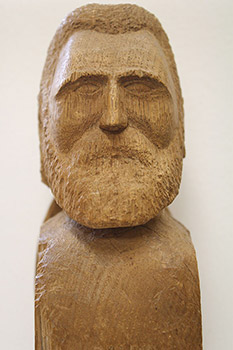
Maker: William Henry Jackson (1861-1952)
Oak
Lower Fort Garry National Historic Site
HG.64.20.2
This miniature oak bust of Louis Riel was completed by William Henry Jackson (1861-1952) while he was an inpatient at the Manitoba Asylum. Jackson was the secretary of the North-West Settlers' Union in December 1884. With Riel, he co-drafted a petition to the federal government lobbying for Métis rights. After the resistance in 1885, Jackson was captured alongside Riel and put on trial; however, due to concerns about his mental health, he was found not guilty and admitted to the Manitoba Asylum at Lower Fort Garry. This asylum, which was later relocated to Selkirk, was the first asylum in Manitoba. The institution, run by Dr. David Young, was notable for its emphasis on therapy, and its humane treatment of inpatients in comparison to other mental hospitals in Eastern Canada and Europe. Dr. Young writes about Jackson’s arrival in his journal on August 14, 1885, describing him as a “rather thin” man with an “intense admiration for Riel” and his cause. Jackson gave Dr. Young the miniature carving of Riel later that year. He later escaped from the asylum and settled in Chicago and then New York.
The carved portrait attached to a three-piece wooden support features a bearded Riel with the name “Louis David Riel” inscribed onto the front and sides of the bust. Over time, the dry wood split in places, and the support bracket was damaged due to the insertion of a modern screw. In 1992, the artefact was conserved by Parks Canada in order to prevent further deterioration: the base was dismantled and the screw was removed, old glue joints were cleaned, and splits were filled with fresh glue to improve appearance and prevent further cracking. The bracket and bust were then carefully re-attached, and inpainting was done where there were inconsistencies in the object’s surface appearance.
Magic lantern
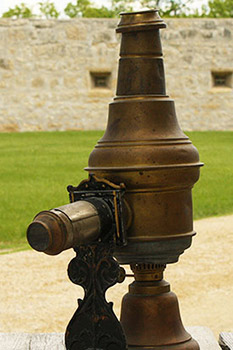
Brass plated tin on wooden base
Lower Fort Garry National Historic Site
X.68.204.10
Magic lanterns are early slide projectors used to present sequences of individual images. Invented in the mid-17th century, the magic lantern was used as a source of public entertainment long before the invention of modern video technology. The devices were popularized in the 18th century and early 19th century, when they were often used to present shows of frightening images: a genre of theatre known as phantasmagoria. By the mid-19th century, the technology was also applied to more morally edifying and educational ends, including current news, Bible stories, and children’s tales. Travelling showmen went from place to place, offering magic lantern shows in community venues like public halls, churches, and homes.
The magic lantern currently housed in the Sales Shop at Lower Fort Garry is a German model from the 1890s. The device, resting on a wooden base, is comprised of an oil lamp and an arm that juts outward ending in focusing lenses. Individual slide images could be projected through the lens when the lamp was lit. While there are no official company records that point to the shipment of magic lanterns on HBC boats, there is documentation of a magic lantern in Gimli, Manitoba by 1878. Travelling showmen may have made journeys up to the Red River Settlement – travelling, for instance, by steamboat from places like St. Paul. Since prices for lanterns and slides were becoming more reasonable by the mid-1800s, it is also possible that HBC employees ordered these items themselves.
Site Collections Staff conduct regular cleaning and inspections of the magic lantern to ensure its continued preservation and survival.
Pianoforte

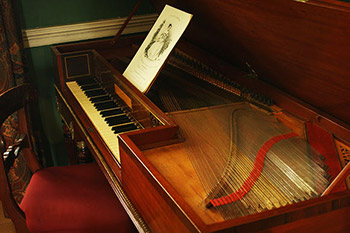
Mahogany, brass, wire, and other materials
Lower Fort Garry National Historic Site
X.68.35.1
Of the instruments brought over to Rupert’s Land from England and Eastern Canada, pianos – then called pianofortes – were among the most expensive, and certainly the most challenging to move. The instruments had to be transported by York boat and carried by the tripmen during portages. Having a piano in a rural Rupert’s Land HBC post was a sign of social class and wealth, as well as a nostalgic reminder of the cultured upper class urban lifestyle to be found to the East and across the Atlantic. In the Red River Settlement, pianos could generally only be found in the parlours of successful HBC officers, clergy, and select wealthy individuals. Over the course of the 19th century, pianos – though still expensive – gradually became more accessible to the growing middle class.
Following in the footsteps of past Lower Fort Garry Governor George Simpson, and other HBC officials, Eden and Anne Colvile had their piano shipped from England in 1851. They bought their rosewood piano from the Royal Harmonium and Piano-Forte Saloon for £43 – expensive considering the average farmer only made about £5 a year. It was sent to the Fort in a protective zinc-lined case and came with 12 pieces of music, a tuning hammer, and tuning instructions. The pianoforte that is currently in the Big House parlour at Lower Fort Garry is not the Colvile’s original piano; however, it is an artefact that is appropriate to the time period and setting. This piano is a square grand made by John Broadwood and Sons, a popular manufacturer due to the affordability and quality of their instruments. The six-legged pianoforte is made of mahogany with a section of rosewood veneer, and also features decorative brass floral panels, and a row of beaded moulding in brass along the front and sides.
The piano has undergone several conservation treatments by Parks Canada conservators to ensure that it can still be played today. In 1984, conservators repaired a crack in the sound board; fixed the legs, which were missing some hardware and needed to be relocated to their original positions; made repairs to the veneer, which was splitting and lifting; and, cleaned the tarnishing brass ornaments. After this, the entire instrument was hand rubbed with rottenstone and cutting oil, then coated with paste wax to protect the beautiful finish.
Moccasin bead pattern
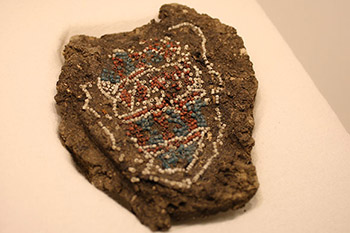
Glass, soil matrix
Lower Fort Garry National Historic Site (Originally from York Factory)
PRO.351.84
This archaeological artefact features the remains of a moccasin vamp that was found at York Factory beneath the Depot building. Originally, as a piece of leather with ornate glass beadwork, this vamp, along with a matching vamp for the other foot, would have been sewn on the top of the moccasin. The beaded pattern in blue, white, and red, provides an example of the craftsmanship and design that was often worked into traditional First Nations clothing. Moccasins, often made of deerskin, protected the feet of wearers while also allowing for quiet movement and flexibility due to their soft soles. This type of footwear, originally worn by the First Nations peoples, was also adopted by hunters and fur traders of European and Métis descent in the Red River Settlement.
This object is a remarkable find because it is unusual to uncover artefacts made of organic materials with beaded patterns still intact. In order to preserve the artefact and maintain the beadwork for the future, Parks Canada conservators used a solution of white carpenter’s glue to secure the beads to remnants of the mud in which it was found. A sample of the earth recovered along with the artefact was also carefully sealed and shipped out for lab analysis.
Two side chairs from the Motor Country Club era
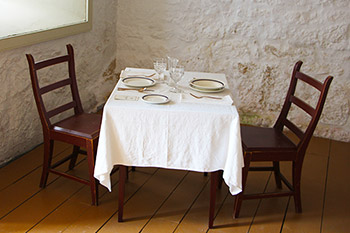
Date Used: 1920-1960
Registration numbers: HG.62.22.39D; HG.62.22.39C
From 1913 to 1962, the Big House at Lower Fort Garry served as the club house for Manitoba’s Motor Country Club. These two handmade wooden side chairs, and four others from this set that are now in the Parks Canada collection, were used in the house during this period. Various photos of the Big House during this era confirm the presence of these chairs in the clubhouse restaurant. In 1962, when the club’s lease ended, Parks Canada purchased a variety of antiques and goods that the club had acquired for the Big House over the years and these chairs were among those items.
These are bentwood chairs, meaning that the wood was steamed in order to make it flexible and then the boards were bent into shape. Though Lower Fort Garry today animates the Fort in the fur-trade era of the mid-19th century, an exhibit in the Big House pays tribute to the building’s Motor Country Club era and it includes these chairs as well as a variety of other artifacts and photographs from the Motor Country Club period.
Grammar books belonging to Donald Ross and family
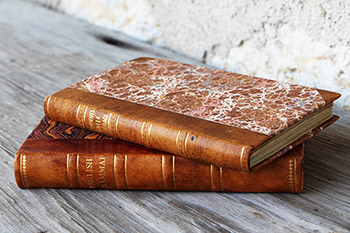
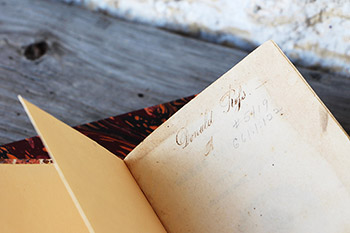
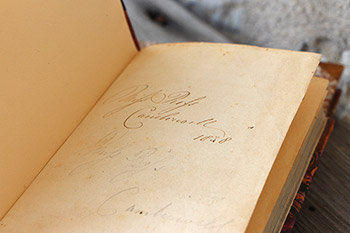
Archibald N. Carmichael, Rudiments of the Greek Language for the Use of the Edinburgh Academy, 4th ed., enlarged and improved (Edinburgh and London: Oliver & Boyd, Weedale Court and Simpkin, Marshall, & Co., 1837).
Registration no.: HG.61.1.122
These two books originally belonged to HBC Chief Factor of Norway House Donald Ross (1797-1852) and his family. The Ross family lived in the guest cottage at Lower Fort Garry from 1851 to 1852. Donald Ross moved to Lower Fort Garry at the end of his long career with the Hudson’s Bay Company because he was suffering from consumption (tuberculosis) and it was hoped that the climate in the south would alleviate his symptoms.
Donald Ross signed his copy of the Rudiments of the Greek Language for the Use of the Edinburgh Academy (1837) on the first blank page in the book, and again in a different script on the last page of the book. English Grammar Adapted to Different Classes of Learners (1834) by Murray Lindley is signed “Miss Ross Camberwell 1838,” once in ink and once in pencil. The book was perhaps purchased in 1838 in Camberwell – a neighbourhood in London – by Jean Ross, the Ross’s eldest daughter. This grammar book was very popular as a textbook in both England and North America. First published in 1795, the text went through 50 different editions. Two different kinds of “s” are used in the signatures of both Mr. Ross and Miss Ross. The “s” that appears as an “f” is known as a “long s” and it was often used in both mechanical printing and penmanship until the 1790s. These signatures demonstrate the long “s” was retained in some more old-fashioned penmanship into the second half of the 19th century.
All officers of the HBC were given an allotment of cargo space on brigades travelling to and from England according to their rank. This space could be used for goods such as books and other personal effects. Books could be ordered by writing directly to a bookseller in England, or writing to the Secretary in London. Since books were usually imported privately, there are no records of HBC book orders. From available information, it seems that grammar books were not as commonly ordered as were reference materials such as dictionaries and encyclopedias, non-fiction texts, and fiction by authors such as Shakespeare, Charles Dickens, and Walter Scott.
The traditional Christmas tree and ornaments

On December 23, 1848, an article published in The Illustrated London News featured a detailed drawing of Queen Victoria and Prince Albert with their family gathered around an elaborately decorated tree in Windsor Castle. The tree is a royal German Christmas tradition; it was eight feet tall and had six tiers of branches. The branches were decorated with candles, sweet treats, fancy cakes and candy suspended in baskets with colored ribbon. The tree stood on a small table covered in cloth and underneath were gifts of larger sweets, dolls and toys for the young members of the royal family. At the very top of the tree was the small figure of an angel with outstretched wings holding a wreath.
Queen Victoria and Prince Albert’s Christmas tree is recreated at Lower Fort Garry’s Red River Christmas. Look for traditional Christmas tree ornaments from the Parks Canada Collections: colourful pressed glass candle lamps, paper dolls decorated with tinsel, and Santa figures of moulded glass. This is livened up with ornaments made of fruit, popped corn and cranberries – typical of the time period.
The very first Christmas card
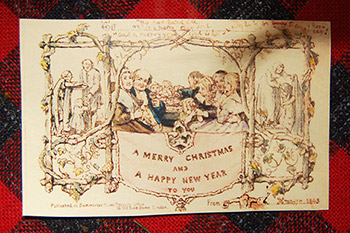
The first Christmas card was sent by Henry Cole (1808-1882), a civil-servant, educator, inventor and the first director of the Victoria and Albert Museum in London, England. In the 1840s, he was a key leader in reforming the British postal system. He helped set up the Uniform Penny Post which encouraged the exchange of seasonal greetings on visiting cards through the post. As unanswered mail piled up, Cole decided a timesaving solution was needed. Cole sought out his friend, John Callcott Horsley, to illustrate a Christmas card that could be mass produced and sold all over London. On December 17, 1843, the card design was bought, and the first Christmas card was sent to Cole from Horsley with a personalized message and small self-portrait in substitution for his signature in the bottom right corner.
The card sold for a shilling a piece, quite expensive at the time, and was soon considered a commercial failure. However, in 1848, Prince Albert introduced German Christmas traditions into English culture. This included the traditionally decorated Christmas tree as mentioned in a Christmas supplement from The Illustrated London News. Soon, Christmas cards, keepsakes and Christmas-themed books, such as A Christmas Carol by Charles Dickens, were sold to middle-class citizens in England who could afford the luxury. Thus the Christmas trend was established in England in the 1870s.
Reproductions of the first Christmas card and other designs are available for visitors to write in during Red River Christmas, with a nib pen! An 1896 copy of The Night Before Christmas is on display at the Big House. Also, watch for “Charles Dickens” who will read from the replica book of A Night Before Christmas.
Reference: Victoria and Albert Museum “The first Christmas card”
- Date modified :